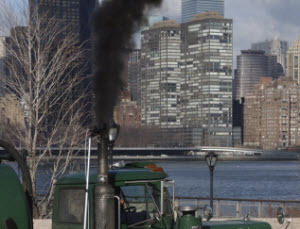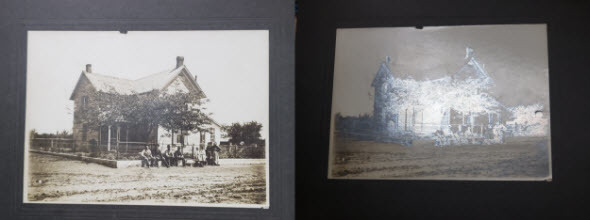Black Carbon and A Picture of Air Pollution - Air Mail!
The New York State Department of Environmental Conservation sent this bulletin on 10/15/2021 02:46 PM EDT |
| DEC Delivers - Information to keep you connected and informed from the NYS Department of Environmental Conservation |
| Share or view as a web page || Update preferences or unsubscribe |
This Month's Topics: |
Public & Stakeholder Participation Information:
Air Mail! is the publication to announce public and stakeholder information about air quality topics. All NYS residents are environmental stakeholders – we welcome anyone to join the information sessions and other opportunities posted here. Black Carbon: More than just Soot, it’s a Health RiskBurning fuel, like wood and gasoline, happens around the world every day. Most of the time, we burn fuels to make heat or power engines. Sometimes the burning happens by accident, as in the case of wildfires. Most of the time, the process of burning fuels creates emissions in the form of visible smoke. Black carbon is a significant component of fine particulate matter pollution and a key ingredient in “soot.” It’s a solid form of carbon that can be over 30 times smaller than the width of a human hair. These tiny carbon particles can travel deep inside the body through the lungs and into our blood, causing arrhythmias, changes in blood pressure, trigger asthma attacks and premature death in people with preexisting heart or lung diseases. Fine particulate matter is also a major contributor to climate change; second only to carbon dioxide (CO2). Black carbon is produced by burning fossil fuels and organic matter (trees and plants). A study in New York found that the amount of black carbon present in the atmosphere can vary widely with time and location. The amount of black carbon that people inhale at a specific time and place depends on what is happening around them.
Even now, fine particulate matter and black carbon pollution remain a potential health risk. Limit your contribution to black carbon pollution by carpooling more often, lowering your use of diesel engines, and following NYS open burning regulations. You can save money, reduce wildfire risk, and keep our air clean and easy to breathe. Photo Caption: Environmental Conservation Officers stopped this diesel truck to inspect its emissions control devices, which were not functioning properly. DEC regulates vehicles, industries, and outdoor fires to reduce air pollution and safeguard public health and our environment. A Picture of Air PollutionExposure to light typically gets most of the blame for fading photographs. However, air pollution can sometimes be an even bigger cause. The inks, pigments, and metals used in photography can chemically react with air pollutants and degrade images, even in the absence of sunlight. This is not a big problem in modern cases since the process is slow and the original digital photograph can just be reprinted. However, it's not that simple when it comes to historic photographs with only one original copy. Protection from air pollution is something that needs to be considered to preserve them. Ozone is one of the most damaging pollutants to photographs. Ozone is made by a photochemical reaction between nitrogen oxides (NOx) and volatile organic compounds (VOC), both of which can be released by burning fossil fuels. Ozone is a highly reactive gas that can interact with and damage many different substances, including those used in a wide variety of print types. For example, “gelatin silver” prints (most 20th-century black-and-white photographs) degrade in a way known as “silver mirroring.” The silver in the images can react with ozone, and other pollutants, causing a sheen to develop on the surface of the image. Nitrogen oxides, and even indoor fumes from solvents and paint, can have the same effect. On the other hand, dry deposition of acids can make the paper more brittle and cause other types of prints to fade in different ways.
The effect of pollution on photographs is cumulative, so even low concentrations can be damaging if exposure is long-term. Warm and humid conditions also worsen this process by speeding up the chemical reactions at the root of the degradation. The Library of Congress (LOC) recommends storing photographs in an area with humidity and temperatures as low as possible for this reason. The LOC also suggests filtering incoming air, ensuring good air circulation, and avoiding drafts of unfiltered air from outside. Storing photographs in airtight sleeves or boxes can also help. While this advice may be most important for institutions with historical collections, it also applies to anyone with old family pictures or modern inkjet prints they plan on preserving for a long time. In addition to protecting your photographs, learn what you can do to limit air pollution. Follow NYS open burning regulations and avoid products with unhealthy fumes to help protect your health and your photographs. Photo Caption: A 100+ year old gelatin silver print, seen in two different angles of light, displaying silver mirroring. Helpful Links:
Dates to Remember:
Stay Informed about Your Air QualityNYS' ozone season runs from April through September. DEC publishes ground-level ozone forecasts during ozone season and particulate matter pollution forecasts year-round using a scale called the Air Quality Index (AQI). DEC sends out an air quality alert when there is a high AQI value, which indicates polluted air. Individuals with pre-existing respiratory or cardiovascular conditions, and people who exercise outdoors should take caution during an air quality alert. Find out if an Air Quality Alert is in effect by calling the toll-free Ozone Hotline: 1-800-535-1345. The AQI can be accessed in three ways:
Connect with us at Air Mail!Did you enjoy reading this issue? Perhaps your friends and family would too. Share Air Mail! by using the “Share” button below. If you would like to receive Air Mail! in your own email box, sign up now! We would also like to know what you think. Send your Air Mail! questions and comments to the team at DAR.web@dec.ny.gov. |


 Overall, black carbon pollution has dramatically decreased since its peak. During the late 19th and early 20th centuries in America, many homes and large factories burned
Overall, black carbon pollution has dramatically decreased since its peak. During the late 19th and early 20th centuries in America, many homes and large factories burned 